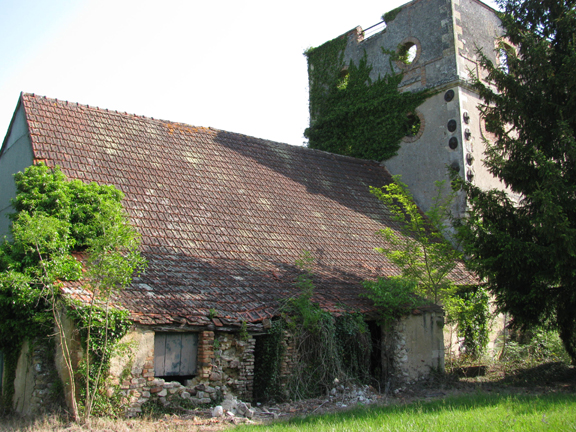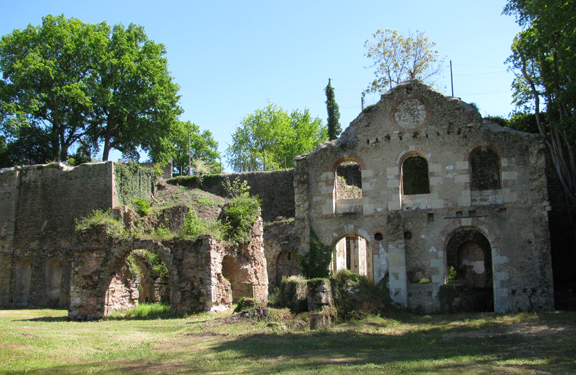
You’d be the rare traveler, French or foreign, to have heard of the Val d’Aubois, the Aubois Valley, a largely bypassed portion of Loire country, so it’s best to begin with a look at the map.
I hadn’t heard of the area myself until the local association Aubois de Terres et de Feux invited me to have a look at their heritage sites. That heritage is mainly industrial, particularly the ruins and remnants of 19th-century ironworks in what is now an agricultural region for growing colza and grain and raising Charolais cattle.
As you can imagine from the above description, I came across no breathtaking beauty, no culinary wonders, no picturesque villages or local festivities here.
Oh, I learned a lot over the course of a day-long visit— how iron ore from the mineral-rich soil in the valley was mined and transformed to produce increasingly refined iron thanks to the evolution of furnaces in the 18th and 19th century—but would a traveler venture this way to see the ruins of smelting plants and foundries like this?

Or this?

Would a traveler wander off course from Burgundy to the east or from the royal chateaux to the west to investigate other signs of 19th-century industry, such as this canal-bridge of the 1830s?

Would a traveler, faced with the knowledge that in the latter half of the 19th-century the iron industry was extinguished due to lack of local coke (coal) for higher-temperature furnaces, depletion of mines, and competition from the larger mines of Lorraine (northeast France), be interested to know that one of the old iron plants has been replaced with a factory making tiles for historical monuments?
I doubt it.
Yet one of the most fascinating aspects of going well off the beaten track in France is catching glimpses of the dedication, stubbornness, vision, and perhaps folly of local individuals trying to preserve something that time and economics have clearly given up on, something of no great beauty that could fall or fade into oblivion without doing any visible harm.
Local associations with this passionate, curious, and/or learned members, the mayors of villages and small towns helping to put or keep their municipality on the map and create a few jobs in the process, the individuals who actually own some of these sites, and their constant and collective search for local, regional, national, and European funding: those are the elements of that the peculiar notion of French heritage.
Among them are the dedicated members of the association Aubois de Terres et de Feux.
There’s also Jacques Chevau, who decided long ago that he wanted to own a castle and in 1998 bought the dilapidated Chateau de Grossouvre.

Grossouvre combines a 12th-century tour with elements of a 14th-century fortress and 19th-century pleasure palace owned by the Marquis Aguado who once hosted Napoleon III and Rossini and other notables of the middle of the century. That was a time when the iron industry flourished in Val d’Aubois. The town of Grossouvre itself is home to a didactic museum concerning the iron industry in the area.
But iron isn’t Mr. Chevau’s concern as much as stone. The eclectic heritage represented by this castle is undoubtedly of limited significance in the vast landscape of manors, palaces, and castles throughout France. Nevertheless, pride in ownership and achievement in its stone-by-stone renewal and repair have now made local and national heritage inseparable from Mr. Chevau’s own. Some day, says Mr. Chevau, the castle will house and display to the public his extensive private collection of old arms and uniforms.
Different approach, different finances, different setting, same distinctly French relation to old stones, there are Monsieur and Madame Mangeot, seen below standing by the ruins on their property of the Abbey of Fontmorigny, which they purchased in 1987. (My apologies to Mr. Mangeot for clicking while his eyes were shut, but I only had one shot before running to catch the train.)

“We didn’t pay a lot,” says Mr. Mangeot, who earned his bankroll as an executive in the pharmaceutical industry, “but the cost isn’t in the purchase price.”
Fontmorigny was originally built by the Benedictine order but joined the Cistercian fold in 1149. Its remnants date from the 12th through 18th centuries, and in the 19th century housed workers from the nearby ironworks at Torteron (see ruins above). Mr. Mangeot calls Fortmorigny “a crossroads of the monastic world and the world of industry”—now there’s a proprietor with a sense of heritage!
Given that nature had taken full position of their ruins by the time they bought it, local, regional, or national government were not about to put money in the project to get it going, but the Mangeots have managed to combine their finances, professionally honed business savvy, and personal passion to get the ball rolling so as to rehabilitate in contemporary terms a piece of French heritage and to open it to the public. Occasional classical music concerns are held here, and a portion of the complex is now being turned into a B&B. Seehttp://www.abbayedefontmorigny.com/ for details.
Owning heritage, restoring or reviving it in one way or another, and opening it, at times, to the public, is a particularly French kind of noblesse oblige, whatever one’s birthright. Visiting the Val d’Aubois might require too much of a detour to discover that here. Indeed the traveler finds it in all forms in France—wine, cuisine, chateaux, mills, churches… foundries.
How to meet the dedicated, stubborn, vision, perhaps foolish individuals who would be so passionate about such things? First of all, think of them as heritage rather than things. Then go into a local café or restaurant and ask, “Who owns that ruin up the road?” It might start of a great adventure.
Travel tips: From a visitor’s point of view the Aubois Valley is do-it-yourself territory. Aubois de Terres et de Feux is the best place to begin your research.
However the obscure the area may sounds, we are indeed in the Loire Valley here, albeit far removed from the zone promoted as the Valley of the Kings. Though not a wine-growing area, this area can be situated in Loire wine terms as being 20-40 miles south of Sancerre and Pouilly (Pouilly-Fumé). Most visitors exploring the Loire Valley by bike focus their pedaling on the zone between Saumur and Blois. Nevertheless, the extensive marked cycling routes of the cross-regional Loire à Vélo (Cycling Loire) project will soon reach so far as Val d’Aubois.
(c) 2010, Gary Lee Kraut

